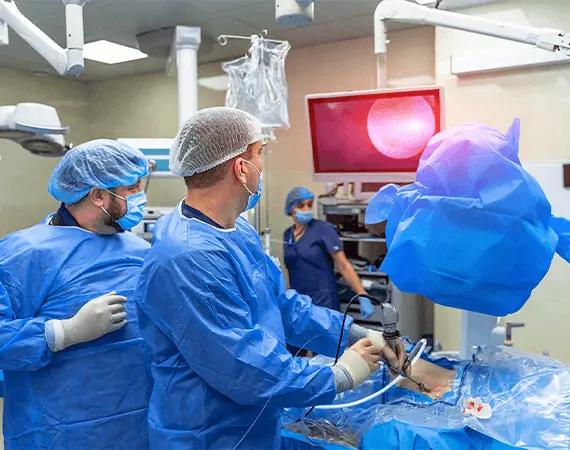
Laser treatment for kidney stones has revolutionized the way urologists address this painful condition. As a minimally invasive procedure, it offers a high success rate and numerous benefits compared to traditional surgical methods. In Pune, Dr. Abhijit Gokhale, a highly experienced urologist, and andrologist, provides advanced kidney stone treatment options, including laser lithotripsy, at his clinic in Shivajinagar. With 25 years of expertise in urology. At Sanjeevan Surgery in Shivajinagar, Pune, He employs state-of-the-art techniques for kidney stone removal, including laser lithotripsy.
What Are Kidney Stones?
Kidney stones are hard mineral deposits that form in the kidneys. They can vary in size and composition, with common types including calcium oxalate, struvite, uric acid, and cystine stones. The formation of these stones can cause significant pain, especially when they move through the urinary tract. Symptoms may include:
Severe pain in the back, side, or abdomen
Nausea and vomiting
Blood in urine
Frequent urination or an urgent need to urinate.
How Does Laser Treatment Work?
Laser treatment for kidney stones, specifically known as laser lithotripsy, is a minimally invasive procedure that utilises focused laser energy to break down stones into smaller fragments. Here’s a step-by-step overview of how the process works:
1. Diagnosis and Planning
Before undergoing laser treatment, patients will have imaging tests such as a CT scan or ultrasound to confirm the presence of kidney stones and determine their size and location. This information is crucial for planning the procedure effectively.
2. Anesthesia Administration
On the day of the procedure, patients are typically given anesthesia to ensure comfort during the surgery. Depending on the case, this may involve general anesthesia or sedation.
3. Insertion of Ureteroscope
A thin, flexible tube called a ureteroscope is inserted through the urethra and bladder into the ureter or kidney where the stone is located. This allows the surgeon to visualize the stone directly.
4. Laser Fragmentation
Once the ureteroscope reaches the stone, a laser fiber is introduced through it. The laser emits precise pulses of energy that break the stone into tiny fragments without damaging surrounding tissue. This method is highly effective for various types of stones.
5. Removal of Stone Fragments
The fragmented pieces can either be small enough to pass naturally through urine or may need to be removed using specialized tools through the ureteroscope.
6. Recovery Process
The entire procedure usually lasts between 30 minutes to an hour. Most patients can go home on the same day, although some may require an overnight stay for monitoring.
Benefits of Laser Treatment for Kidney Stones:
Laser lithotripsy offers several advantages over traditional surgical methods:
Minimally Invasive
One of the most significant benefits is that it is minimally invasive. Unlike open surgery, which requires large incisions, laser treatment involves only small openings or none at all, leading to reduced recovery time and lower risk of complications.
High Success Rate
Laser treatment has a high success rate for breaking down kidney stones into manageable pieces that can be easily passed or removed. This makes it an effective option for patients with larger or more complex stones.
Reduced Pain and Discomfort
Patients often experience less pain during and after the procedure compared to traditional methods. The precision of laser technology minimizes damage to surrounding tissues, leading to quicker recovery times.
Preparing for Laser Treatment
Preparation for laser treatment typically involves:
Consultation: Discussing medical history and undergoing necessary imaging tests.
Pre-operative Instructions: Patients may be advised on dietary restrictions or medications to avoid before surgery.
Hydration: Staying well-hydrated before the procedure can help facilitate better outcomes.
What to Expect After Laser Treatment
After undergoing laser lithotripsy, patients may experience some temporary side effects such as:
Mild discomfort or burning sensation during urination
Blood in urine for a few days
Increased urgency to urinate
These symptoms usually resolve within a few days. Patients are encouraged to drink plenty of fluids to help flush out stone fragments and reduce discomfort.
Risks and Considerations:
While laser lithotripsy is generally safe, there are some risks involved:
Infection: As with any surgical procedure, there is a risk of infection.
Bleeding: Some bleeding may occur but is typically minimal.
Incomplete Fragmentation: In rare cases, not all stone fragments may be broken down sufficiently.
Patients need to discuss any concerns with their healthcare provider before undergoing treatment.
In conclusion, kidney stone treatment in Pune has evolved significantly with the advent of advanced techniques such as laser lithotripsy. This minimally invasive procedure offers numerous benefits, including a high success rate, reduced recovery time, and minimal discomfort for patients. With the expertise of skilled urologists like Dr. Abhijit Gokhale, who brings over 25 years of experience in the field, patients can expect personalized care tailored to their specific needs.












Write a comment ...